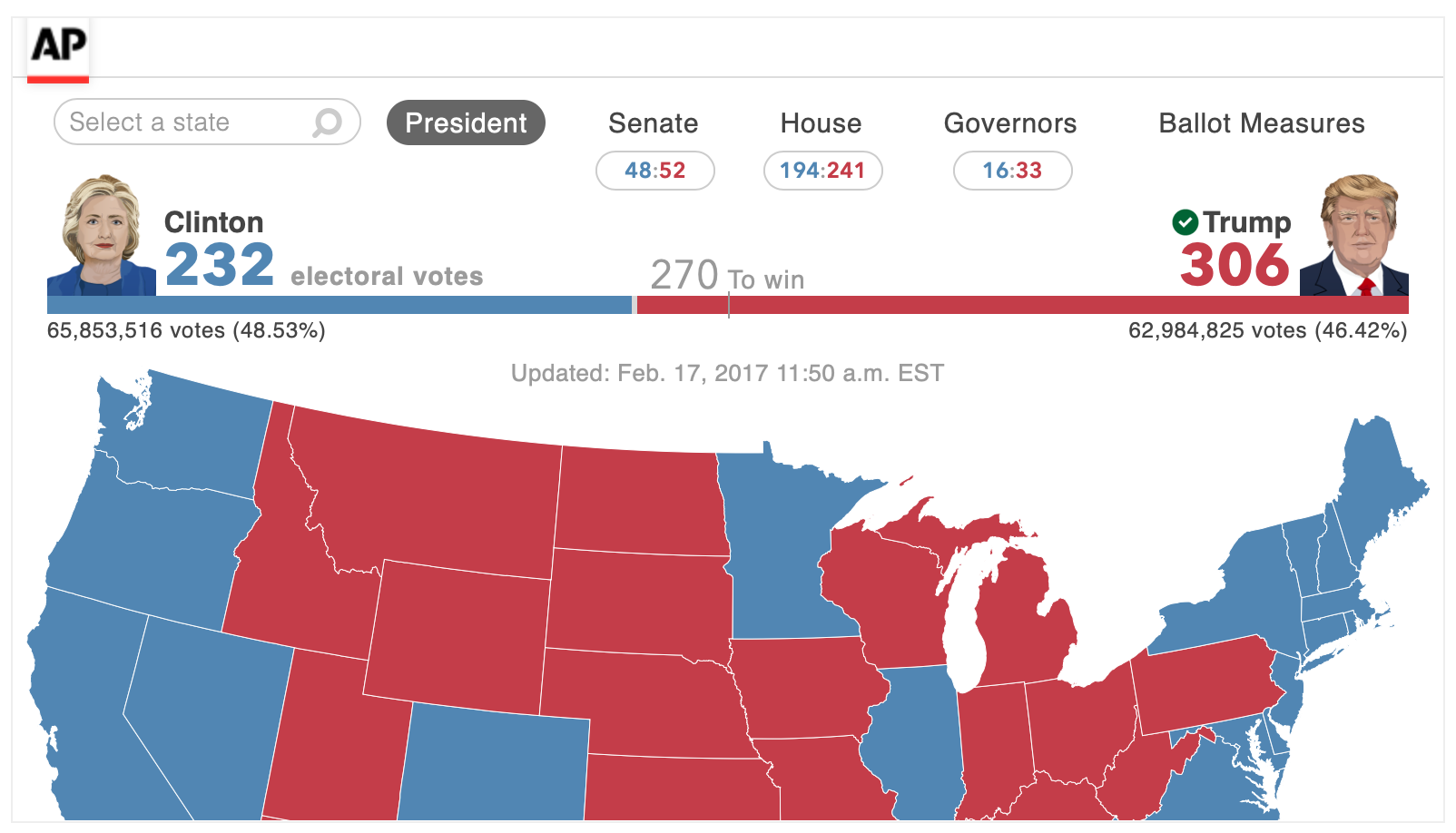Election coverage, part 1: How a Bad Graphics Department Could Hurt Democracy
n.b.: This is part one of a two-parter. If it scares you (which it probably should), be sure to read part two as well.
A sample graphic from 2016, from the AP’s Election Services marketing site.
The Media Must Update its Election Coverage, before November 3
What if, in this year’s election, the peaceful transition of power rests on split-second decisions made by major television network producers and the prep work done in their graphics departments? We’ve seen the president use the media as a tool for his own advancement ever since first announcing his candidacy, alleging that the only true reporting were stories that flattered him and that the only true election results were ones that favored him. And, over and over again, he was able to generate headlines and draw attention toward—or away from—whatever he wished with his antics. This poses a big risk for the 2020 election.
After the 2016 election, there was a season of performative newsroom hand-wringing and reflection, but little has changed. Just take the headlines after the first presidential debate, many of which ran along the lines of “Candidates Traded Insults,” missing the raging forest fire for the trees. Describing the debate as “full of interruptions” may technically be accurate, but it failed to precisely describe what occurred or the significance of the president and his family’s flagrant breaking of the agreed-upon health precautions, or his refusal to cede speaking time. His message was clear: I am beholden to no one. But most media did not convey that message.
That’s why the cliches of election-night television coverage—like breathless counting down to poll closures, reporting percentages before they are statistically significant, and racing to be the first to “call” each state—must be done away with. Journalists and watchdogs like the Transition Integrity Project and the National Task Force on Election Crises have already begun identifying unique risks in this election and calling for media transparency and accountability around election coverage. Explicit and plentiful expectation-setting per their recommendations should begin now, with these steps:
Tell the public—starting now!—how and why some states may not finish counting votes on November 3. For example, while there is a massive uptick in people choosing to vote by mail, swing states like Pennsylvania, Wisconsin, Michigan, and New Hampshire don’t allow officials to process mail ballots before Election Day.
Ensure all reporters and anchors understand the idea of the “blue shift” and build them into your explanations of day-of polling returns as they come in. In recent years, voting by mail has become more common among Democrats, meaning that before mail-in ballots are counted, initial poll returns may show a “red mirage”—a lead for a Republican candidate, which shifts as all ballots are counted. The president has already begun to undermine a complete count by saying the results must be known the same day as the election. Yet states may not have the resources to do this. To give his “story” credence with headline coverage would lay a path for him to contest the outcome.
Begin reporting now whether states have plans and resources in place to complete a timely ballot count: While Election Day itself is not a deadline for votes to be counted, there is a deadline for a state to certify its vote and appoint electors to the electoral college— December 8. Report ahead of time, and during election night coverage, what you understand of each swing state’s ability to count their volume of mail ballots. The pressure of public scrutiny should be on state election officials. If this isn’t reported on now, officials may be tempted to feign surprise at their difficulties and point to “chaos” as a pretext for taking the nearly-unprecedented but legally possible step of certifying the results without completing the count or, more frighteningly, without honoring it. Reporting already indicates that the Republican Party has begun having conversations with state leaders.
Reporters should familiarize themselves with this and other “what-if” election scenarios simulated by the Transition Integrity Project. Less scrambling to catch up on the obscure aspects of the election process means more sober analysis. Sober analysis is important because the more the process is characterized by surprise twists, shocks, or unknowns, the more the president can sell a story that the election itself is unreliable.
Resist and be on the lookout for overly simplistic and inaccurate “both sides” framings, which many resorted to after the debate. For example, don’t be manipulated into drawing a false equivalency between voter suppression dressed up as “poll monitoring” or “watching for fraud” and actual monitoring at the polls for voter suppression. Voter fraud is a one in a billion occurrence, whereas voter suppression is a time-honored Republican strategy.
Resist the urge to quote the president or his campaign directly as the most fair and efficient way to represent their side of the story. Even when providing context, repeating the president’s tweets risks amplifying the misinformation—because who among us can be pithy and nuanced? The president is predictable; it is easy to imagine what he’ll say if in-person poll results (the “red mirage”) are in his favor during prime time on election night. Consider now whether or not to repeat his assertion if it does not have a legal basis.
Rethink those icons and charts, the countdown-to-poll-closing clocks, and the interactive touch-screen maps. Dream big with the graphics and data visualization teams. Maybe put that “precincts reporting” percentage in a larger point size than the percentages for each candidate! Release the need to be the first to call it.
Those planning this year’s election coverage have the moral weight of the world on their shoulders. The story they tell today will reverberate into the night of November 3rd, and that story will create the conditions for what comes next. All parties should come to the table now and plan for the additional statistics, context, and, yes, graphic design, that 2020 will surely require.
An air of cooperation over competition must prevail. We must demand sober accuracy over dazzling speed. TV stations must resist the desire to provide a horse-race or boxing match style spectacle. If they don’t, we could all lose.



